Spanish Romance (Romanza) – Free PDF Sheet Music or Tab for Classical Guitar with Free Performance and Video Lesson. Comes with both a Notation-Only Edition and a separate Tab Edition. Level is Intermediate, a few big chords, stretches, and upper position (Grade 5-6). YouTube Performance & Lesson.
Spanish Romance (Romanza) – This is an iconic work and may the most popular and well recognized works for classical guitar by the general public. The composer is anonymous. Also known as “Romance Anónimo” (Anonymous Romance), “Estudio en Mi de Rubira” (Study in E by Rubira), “Romance de España”, “Romanza” and “Romance d’Amour” and more titles. Includes fingering.
Free PDF Sheet Music Edition
- Spanish Romance -Romanza (Free PDF) ↓ – Comes with both notation edition and a separate tab editions
Or find it in my Grade 5 Repertoire Lessons Book
- Classical Guitar Repertoire Lessons Grade 5 – Includes a dedicated lesson for this work.
Quick Lesson Tips for Spanish Romance
Score Comments: The use of the E in measure 19 and 20 is used as a pedal point but feel free to play an F sharp with a barre at the 2nd fret if you prefer.
Play the melody on its own. The melody to Spanish Romance is the most important element in the piece. You want to practice the melody on its own and get the phrasing and dynamic shaping to be as high quality as possible. Then, when you add in the accompaniment you try to keep the legato melody as high quality as possible despite of the chord changes and fingering. The melody is the upper voice as shown on the first two lines below.
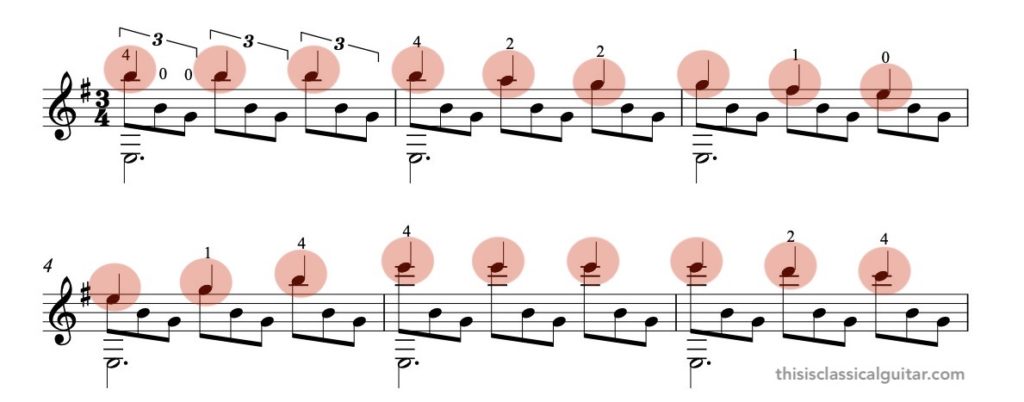
Balance the Voices. You want the melody to be the most prominent. The melody should pop out of the texture without interference from the bass or accompaniment. The bass voice is the next most important and can be fairly present so it can sustain through the measure. It’s quite far away in register from the melody so it won’t interfere much. The accompaniment should be the softest. Try to under-play it so it never interferes with the prominent melody.
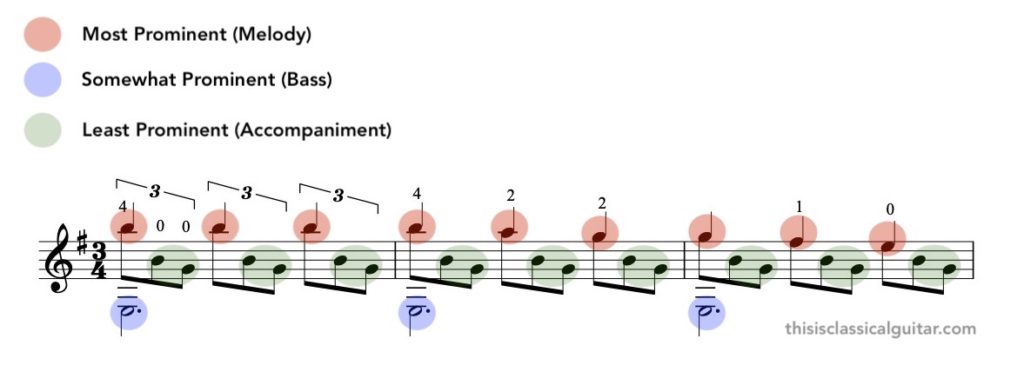
Practice the chord shapes on their own. Getting comfortable with the chord shapes is another aspect of the piece that will need to be practiced. You can do this by practicing the combined notes in a measure or quarter note beat.
Another Video
Some History on Spanish Romance
More info on the piece via its Wiki: “Its origins and authorship are in question. It is suspected of originally being a solo instrumental guitar work, from the 19th century. It has variously been attributed to Antonio Rubira, David del Castillo, Francisco Tárrega, Fernando Sor, Daniel Fortea, Miguel Llobet, Antonio Cano, Vicente Gómez, and Narciso Yepes. The Anónimo (anonymous) part of its name has been incorporated over the years due to this uncertainty. The question of authorship has probably been propagated by three main reasons: the lack of claim by its true author, the desire to avoid paying copyright fees, and the desire of publishing companies to claim the lucrative copyright of this world-famous piece. The style of the piece is that of the Parlour music of the late 19th century in Spain or South America, having a closed three-part form: the first in the minor key and the second being in the major key, with the third being a restatement of the first.”
The piece is certainly not by Sor, that is just way off, but Tarrega would not be a huge stretch. Though, if it was by any legit composers I would imagine the piece has been altered overtime to simplify it and make it more pleasing for mainstream consumption.
Sample Media
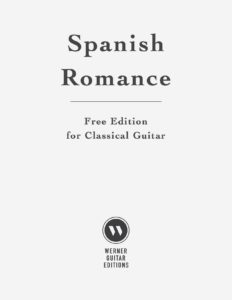
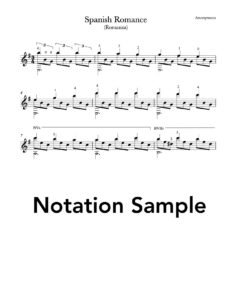
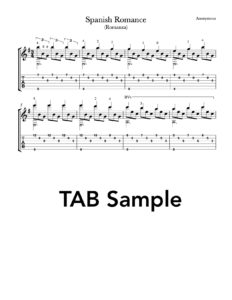
Check out my educational book series
- Classical Guitar Method – Vol. 1, with Video Lessons, 100 pages, Free PDF
- Classical Guitar Method Vol. 2, with Video Lessons, 89 pages.
- Ten Classical Etudes – Progressive etudes for intermediate level.
- Classical Guitar Technique: Essential Exercises, Scales, & Arpeggios – Hundreds of exercises and tons of video lessons. Notation.
- 20 Favorite Exercises, Technique book includes notation and TAB, Video lessons.

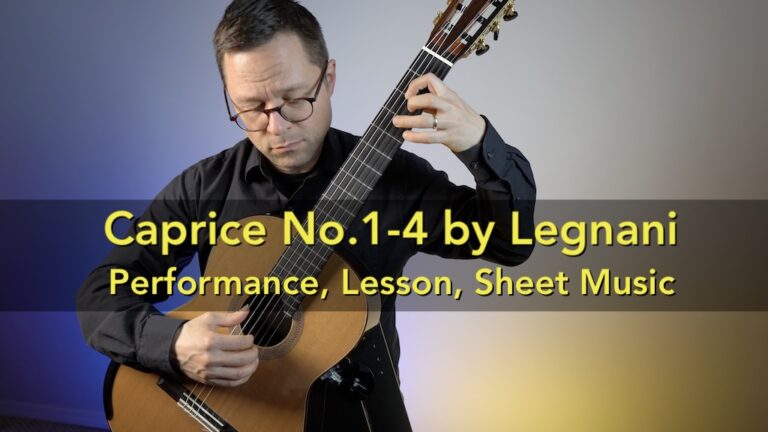
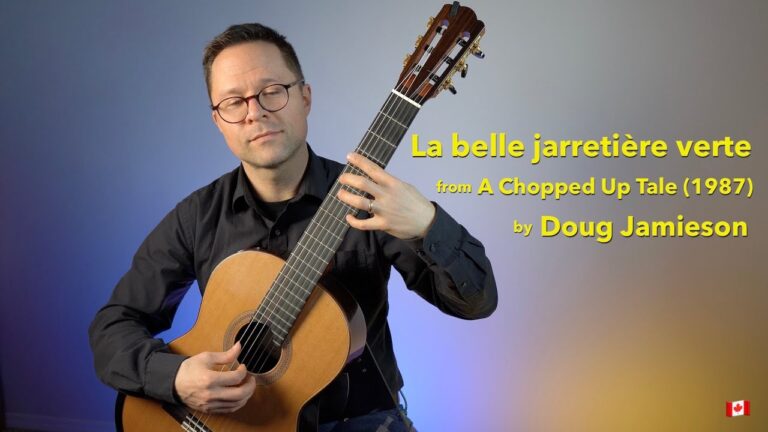
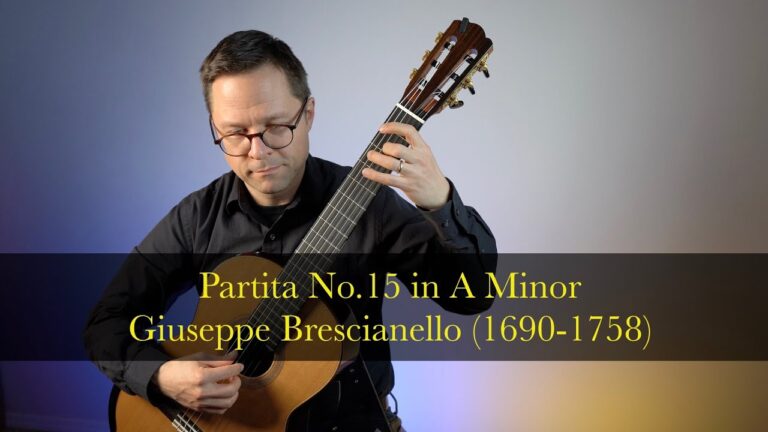
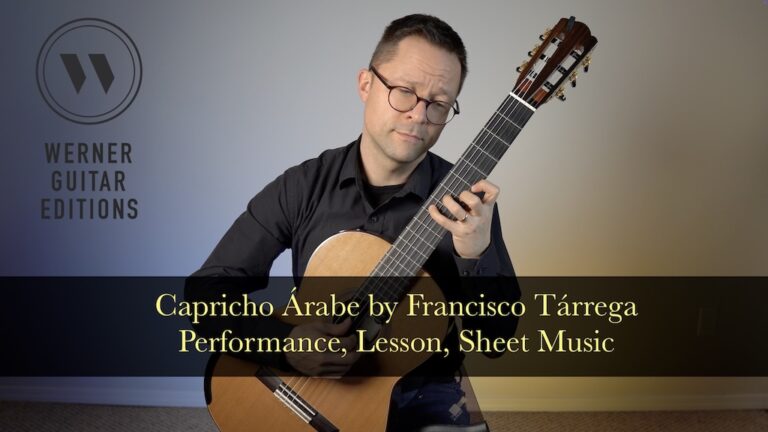
Thank you for your excellent advises about this piece. I have a question concerning bar 19 & 20. The bass note on many edition is a low F# which needs a complete II barré. You play a low E on an open string. Can you explain to me this difference : which is the «good» one ?
Thank you in advance for your answer.
Rémi Lapointe
Since there is no original copy of this work (it’s anonymous), there are many different versions of it out there. So the E in this version is a pedal tone (a repeated bass note over which chords are played that either create tension or release). But if you prefer the F# version, go with that. Both work.
Thanks for a great site…I´m presently practicing this piece and have come across some things I don´t really understand.
In bar 7 it says BV6, should it possibly be BV3?
The BIX3 in end of bar 24 shouldn´t it start in bar 25?
And the BII5 in bar 29 should possibly be in bar 30 instead?
Thanks
/Mans
Hi,
All this measure are correct and intentional as far as I’m concerned.
In measure 7 the BV6 allows you to move it up to the BVII6 that immediately follows allowing you to not have to release the previous barre which might create a hiccup in the music.
In Measure 24 the barre in needed to play those notes with the high D and then continues in the next measure.
In measure 29 and 30 you barre (BII5) for both measures since it is the same chord.
Hi, thanks for the explanation, I now see the reason for it noted this way. Great experience!
One thing though is the 29/30 barre, I think the reason for my question is that I previously studied this piece from an old sheet of mine (by Daniel Fortea) where it is not the same chord in these two bars. In this sheet bar 29 is noted with B and G# instead of D# and A. I guess there is no right or wrong here as the origin is unclear?
Thanks anyway for the clarification, much appreciated.
/Mans
Absolutely correct, there is no definitive version out there so you can choose to use whatever version you prefer.
Although you have it in your grade 5 book, thank you for this free edition. Enjoy your site, I am going to become a patron doner, I feel guilty watching, using and printing all your free stuff. 🙂
Dave
No worries, glad you are enjoying the site, please use it guilt-free!
Why is the intro so rarely performed and printed as a score?
What intro is that? Since the work is anonymous I imagine there are tons of editions with added material.
Brad you have really good site and you play very well thank you rob
Thanks so much Rob!
In the video, you say that c## (double sharp! is there “because that’s how the harmony works out”. Why? It is a melodic line, which is chromatic in this case so that d# goes down to d, which is not a part of E major scale, but… neither is c##.
Wy question is, why did you write is as c##? Is it because for that short part the piece modulates to another scale? If so what scale is it (the one I mentioned before doesn’t match)? Or what roman numeral would you put to that chord so it works out like that?
I’m just trying to understand why. It doesn’t help there are so many different variations out there, some with E, some A, F# or even B or in the bass.
I guess it’s some kind of ii chord (F#m7/E?) in your case. If you write c##, that would be F#m7(#5)/E, right?
But it’s easier to say the piece modulates to E Mixolydian, which has F#m7 chord, and the melody is using D natural which is in that scale.
Sorry if I’m talking nonsense, I’m self-taught and trying to figure it out, might be I’m missing something obvious.
C double sharp is the lower auxiliary to D sharp. Writing it as a D natural would be incorrect. Not every note in a piece is from the key or scale, chromatic notes will come into play in many different circumstances. In this case, it’s just a non-chord tone and a spicy chromatic lower auxiliary to the D sharp. Nothing to overthink and it does not get analyzed as part of the chord. Furthermore, there is a pedal low E in the bar which is also not part of the chord. Actually the whole section functions as a dominant chord (with secondary dominants) that lead to E major. In short, it’s all tension leading to a resolution in E.
Why c## in bar 20? That would make the chord something like E(##6) in Lydian #2 # 6 mode, which seems way over complicated. Why not a simple Em7 with D natural?
Any tips for how to practice the quick barre transitions like 20->21 or 26->27? Also getting F# to sound properly in 10 is quite hard. I must have a long way to go in my barre technique.
There appears to be a small error in the sheet music. Bars 19&20 have an E in the bass, but F# is typically played as seen in the video (second position).
I prefer it as a pedal E in the bass for the beginning of that section. Sounds more stable and is a cooler musical device. But whatever sounds best to your ears….
Completely down to preference of course. I just don’t think it’s what learners will expect to find in those bars. It is less traditional and less harmonically stable, but as you say, whatever sounds best to your ears.
There is an interesting article on Narciso Yepes ( 1927-1997 ) and “Jeux interdits ” (Romanza )
by Rafael Andia in Guitare Classique ( #52, March-May 2011). Yepes would have revealed in 1982 on Spain National Radio that he composed the Romance on his 7th birthday as a gift to his mother. The piece is the soundtrack of the movie Jeux Interdits ( 1952 ) and is often given that title in French. A note: on the free PDF for which I am very grateful there is a typo in measure 19 which was no doubt already brought to your attention.
Bar 19 is not a mistake, it’s just a preference for the ‘e’ to be closed and played on the 5th fret 2nd string. It just sounds better to my ear when it resolves to the d#…
Narciso Yepes was not the author of “Romance”. Sheetmusic and old historic recordings of the work exist, from before Yepes was even born!!
Reference: https://en.wikipedia.org/wiki/Romance_%28guitar_piece%29#Disproved_origins
Thanks. Interesting and informative.
I was playing this in 1948 as a very young girl. It was composed by Vincente Gomez, and includes a very beautiful beginning which none of the other renditions contain.
To my knowledge, neither the Yepes or Gomez claim can be verified with evidence. However, The earliest recording of “Romance” is on a cylinder (from the “Viuda de Aramburo” label) featuring guitarists Luis and Simon Ramírez, made in Madrid sometime between 1897 and 1901.
Some people speculate that the author was none other than Andres Segovia.